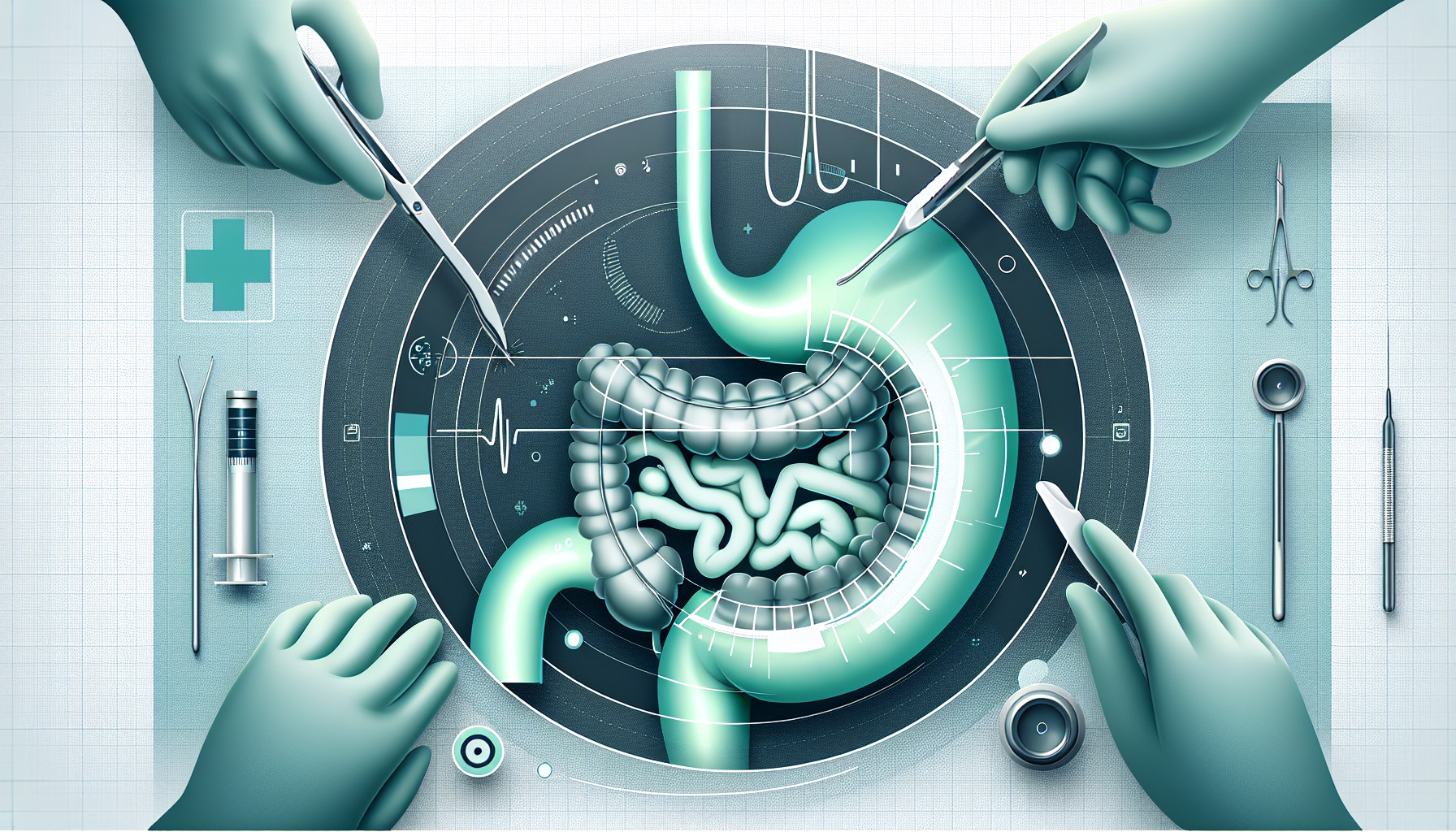Our Summary
This research paper discusses a type of weight loss surgery known as one anastomosis gastric bypass (OAGB). This procedure is viewed as potentially less risky than the more common Roux-en-Y gastric bypass (RYGB) because it involves one less surgical connection (or anastomosis). However, there are concerns about complications following OAGB, specifically the development of ulcers and potential tearing (perforation) at the surgical connection between the stomach and small intestine.
The researchers reported on three cases where patients developed a perforated ulcer after OAGB surgery. In all cases, the patients needed additional surgery to repair the damage. The methods used to fix the problem varied: some patients had the tear stitched up, while others needed the original bypass converted to the RYGB surgery. All patients recovered well and were discharged from the hospital in a stable condition after 4-5 days.
The authors conclude that while a perforated ulcer following OAGB is a serious and potentially life-threatening complication, it can be effectively managed. Quick diagnosis and repair of the perforation are crucial, and the specific surgical approach will depend on the patient’s overall health, details of the perforation, and the surgeon’s expertise.
FAQs
- What is one anastomosis gastric bypass (OAGB) and how does it differ from Roux-en-Y gastric bypass (RYGB)?
- What are the potential complications following OAGB surgery?
- How are perforated ulcers following OAGB surgery managed and repaired?
Doctor’s Tip
One helpful tip a doctor might give a patient considering gastric bypass surgery is to closely follow post-operative care instructions, including diet and activity guidelines. It is important to attend all follow-up appointments and report any unusual symptoms to your healthcare provider immediately, as early detection and treatment of complications such as perforated ulcers are key to successful outcomes.
Suitable For
Gastric bypass surgery, including OAGB and RYGB, is typically recommended for patients who have a body mass index (BMI) of 40 or higher, or a BMI of 35 or higher with obesity-related health conditions such as diabetes, high blood pressure, or sleep apnea. These patients have often tried other methods of weight loss without success and are at high risk for obesity-related complications.
Patients who undergo gastric bypass surgery should also be committed to making significant lifestyle changes, including adopting a healthy diet and regular exercise routine. It is important for patients to understand the risks and potential complications of the surgery, as well as the long-term commitment required for successful weight loss and maintenance.
Overall, gastric bypass surgery is considered a safe and effective option for patients who meet the criteria and have failed to lose weight through other means. It is important for patients to work closely with their healthcare team to determine the most appropriate weight loss approach for their individual needs and goals.
Timeline
Timeline of a patient’s experience before and after gastric bypass:
Before surgery:
- Initial consultation with a healthcare provider to discuss weight loss surgery options.
- Complete pre-operative testing and evaluations, including blood work, imaging studies, and consultations with a nutritionist and psychologist.
- Follow a pre-operative diet and exercise regimen to prepare the body for surgery.
- Attend pre-operative education sessions to learn about the procedure, potential risks and benefits, and post-operative lifestyle changes.
After surgery:
- Recovery period in the hospital, typically 2-3 days for laparoscopic gastric bypass.
- Follow a strict post-operative diet plan, starting with clear liquids and gradually progressing to solid foods over several weeks.
- Attend follow-up appointments with the surgeon and other healthcare providers to monitor progress and address any concerns.
- Begin a regular exercise routine to promote weight loss and overall health.
- Experience rapid weight loss in the first few months after surgery, followed by a slower and more gradual weight loss over the next 1-2 years.
- Adjust to the physical and emotional changes that come with significant weight loss, including changes in body image, relationships, and daily routines.
- Attend support group meetings or counseling sessions to receive ongoing support and guidance in maintaining weight loss and healthy lifestyle habits.
Overall, gastric bypass surgery is a life-changing procedure that requires a commitment to long-term lifestyle changes to achieve and maintain successful weight loss. Patients may experience challenges and complications along the way, but with proper medical care and support, they can achieve significant improvements in their health and quality of life.
What to Ask Your Doctor
- What are the potential complications of gastric bypass surgery, particularly one anastomosis gastric bypass (OAGB)?
- How common are perforated ulcers following OAGB surgery, and what are the risk factors?
- What symptoms should I watch for that may indicate a perforated ulcer after OAGB surgery?
- How is a perforated ulcer following OAGB surgery typically diagnosed and treated?
- What is the success rate of repairing a perforated ulcer after OAGB surgery, and what is the recovery process like?
- Are there any specific lifestyle changes or precautions I should take after OAGB surgery to reduce the risk of developing a perforated ulcer?
- How often will I need follow-up appointments or monitoring after OAGB surgery to check for potential complications like perforated ulcers?
- Are there any alternative weight loss surgery options that may be less likely to result in a perforated ulcer?
- What is your experience and expertise in managing complications like perforated ulcers following OAGB surgery?
- What should I do if I experience symptoms of a perforated ulcer after OAGB surgery, such as severe abdominal pain or fever?
Reference
Authors: Abou Hussein B, Al Marzouqi O, Khammas A. Journal: Obes Surg. 2020 Jun;30(6):2423-2428. doi: 10.1007/s11695-020-04423-5. PMID: 32062846
